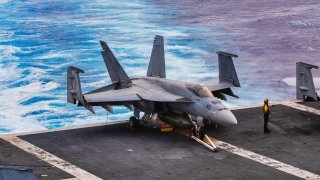Boeing's F/A-18 Block III Super Hornet Is One Incredible Fighter Jet
The F/A-18 Block III Super Hornet gives the U.S. Navy the most networked and survivable F/A-18 built with a technology insertion plan that will outpace future threats
The F/A-18 Hornet is admittedly nowhere near as popular or glamorous as the F-14 Tomcat that preceded her in both real-world aircraft carrier combat operations and cinematic immortality.
Nonetheless, the Hornet has certainly more than proven herself in combat via the aviators of the U.S. Navy and Marine Corps as well as the Canadian Forces, in addition to garnering her own fair share of Hollywood movie audience attention, thanks to the boffo box office of Top Gun: Maverick.
Now that I’ve written explicitly discussing the EA-18 Growler electronic warfare variant, I reckon it’s way past time I did a write-up on the air-to-air fighting Hornet. We’ll focus specifically on the Block III Super Hornet.
F/A-18 Hornet History
The original F/A-18 Hornet was developed by McDonnell Douglas – now part of Boeing – and Northrup – now one-half of Northrup Grumman – as both a fighter and a ground attack aircraft, hence the “F/A” designation.
Accordingly, this jack of all trades ended up replacing not one, not two, but three previous USN/USMC warbirds: the aforementioned Tomcat, as well as the A-6 Intruder and the A-7 Corsair II.
She made her maiden flight on November 18, 1978, and entered operational status on January 7, 1983. That original Hornet quickly established an excellent reputation for combat performance in Operation El Dorado Canyon over Libya in 1986 and would be built upon that combat record via Operation Desert Storm in 1991. For good measure, the original Hornet became the plane of choice for the Blue Angels.
Not content to rest on their laurels, the McDonnell Douglas/Boeing folks came out with the F/A-18E/F Super Hornet on November 29, 1995; this variant entered fleet service with the USN in 1999 and was then ordered by the Royal Australian Air Force (RAAF) in 2007 to replace the Aussies’ aging fleet of F-111C Aardvarks.
Yet the fine folks on Boeing’s R&D team were still not content to rest on their laurels, which now brings us to the Block III Super Hornet.
Block III Super Hornet = Hardcore Hornet
As proudly stated by Boeing’s official info page, “Block III gives the Navy the most networked and survivable F/A-18 built with a technology insertion plan that will outpace future threats.” Whether that “future threats” bit amounts to being able to mix it up with adversarial 5th-generation stealth aircraft like the Sukhoi Su-57 “Bandit” remains strictly conjectural at this point, but for what it’s worth, the Block 3 upgrades exceed those of other 4th-generation fighters, which presumably, at least now, places the Super Hornet in the 4.5 generation category.
Among these upgrades being touted by Boeing: Advanced Cockpit System with a 10-inch-by-19-inch touch screen display, Advanced Network Infrastructure; open mission systems; Block II Infrared Search and Track (IRST) that can detect threats without having to depend on jammable radar; reduced radar cross section (RCS). By contrast, the Block II was only rated for 6,000 flight hours.
Back in 2021, Boeing delivered the first of 78 contracted Block III airframes to the USN.
A contemporaneous article by Naval News founder and Editor-in-Chief Xavier Vavasseur quoted Capt. Jason “Stuf” Denney, U.S. Navy F/A-18 and EA-18G program manager thusly:
“The fleet needs capabilities to keep its edge. Getting the first operational Block III in our hands is a great step forward in supporting our capability and readiness goals.” Vavasseur then went on to quote Jen Tebo, Boeing vice president of F/A-18 and EA-18G programs: “We invested in Block III technology and developed the capabilities in partnership with the U.S. Navy to meet its emerging requirements. The hardware upgrades are complete. Today we are maximizing the open hardware and software and developing the apps to keep Block III ahead of future threats. We are giving Navy pilots the tools to make the fastest and most informed decisions possible now and in the future.”

Until the teething issues with our 5th-generation fighters have been worked out, it looks like it’s going to be up to warbirds like the Block III Super Hornet and her intrepid crews to hold the line against our adversaries.
About the Author
Christian D. Orr is a former Air Force Security Forces officer, Federal law enforcement officer, and private military contractor (with assignments worked in Iraq, the United Arab Emirates, Kosovo, Japan, Germany, and the Pentagon). Chris holds a B.A. in International Relations from the University of Southern California (USC) and an M.A. in Intelligence Studies (concentration in Terrorism Studies) from American Military University (AMU). He has also been published in The Daily Torch and The Journal of Intelligence and Cyber Security. Last but not least, he is a Companion of the Order of the Naval Order of the United States (NOUS).


